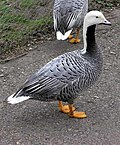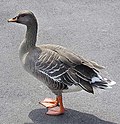Anser (bird)
| Anser | |
|---|---|

| |
| Pair of greylag geese , Anser anser
| |
| Scientific classification | |
| Domain: | Eukaryota |
| Kingdom: | Animalia |
| Phylum: | Chordata |
| Class: | Aves |
| Order: | Anseriformes |
| Family: | Anatidae |
| Tribe: | Anserini Vigors 1825 |
| Genus: | Anser Brisson, 1760 |
| Type species | |
| Anas anser[1] | |
| Species | |
and see text | |
| Synonyms | |
|
Chen Boie, 1822 (but see text) | |
Anser is a
The genus contains 11 living species.[2]
Description
The species of this genus span nearly the whole range of true goose shapes and sizes. The largest are the
All have legs and feet that are pink, or orange, and bills that are pink, orange, or black. All have white under- and upper-tail
Systematics, taxonomy and evolution
The
Phylogeny
The evolutionary relationships between Anser geese have been difficult to resolve because of their rapid
| Anser |
| ||||||||||||||||||||||||||||||||||||||||||||||||||||||||||||
Species
The genus contains 11 species:[2]
| Image | Scientific name | Common name | Distribution |
|---|---|---|---|
 |
Anser indicus | Bar-headed goose | Breeds in highlands of Central Asia; winters in South Asia, Myanmar and southern China; introduced in Europe |
 |
Anser canagicus | Emperor goose | Near the Pacific coast in Alaska, Russian Far East and Canada |
 |
Anser rossii | Ross's goose | Breeds in northern Canada and Alaska; winters in contiguous United States and northern Mexico |
 |
Anser caerulescens | Snow goose | Breeds in northern Canada, Alaska and Greenland; winters in contiguous United States and northern Mexico |
 |
Anser anser | Greylag goose | Europe, Asia and North Africa |
 |
Anser cygnoides | Swan goose | Breeds in Mongolia, northernmost China and southeastern Russia; winters in southeastern China |
 |
Anser fabalis | Taiga bean goose | Breeds in Russia, Finland, Norway and Sweden; winters in Europe, and Central and East Asia |
 |
Anser serrirostris | Tundra bean goose | Breeds in northern Russia; winters in Europe, and Central and East Asia |
 |
Anser brachyrhynchus | Pink-footed goose | Breeds in Iceland, Svalbard and Greenland; winters in northwestern Europe |
 |
Anser albifrons | Greater white-fronted goose | Breeds in northern Canada, Alaska, Greenland and northern Russia; winters in contiguous United States, northern Mexico, Europe, East Asia, Iraq and near the Caspian Sea |
 |
Anser erythropus | Lesser white-fronted goose | Breeds in northern Russia, Finland, Norway and Sweden; winters in East Asia, near the Caspian Sea, and in southeastern and northwestern Europe |
The following white geese were separated as the genus Chen. Most ornithological works now include Chen within Anser,[11][12][13][14]
- Snow goose, Anser caerulescens
- Ross's goose, Anser rossii
- Emperor goose, Anser canagicus – sometimes separated in Philacte
Some authorities also treat some subspecies as distinct species (notably the tundra bean goose[15][16]) or as likely future species splits (notably the Greenland white-fronted goose).[17]
Fossil record
Numerous fossil species have been allocated to this genus. As the true geese are near-impossible to assign osteologically to genus, this must be viewed with caution. It can be assumed with limited certainty that European fossils from known inland sites belong into Anser. As species related to the Canada goose have been described from the Late Miocene onwards in North America too, sometimes from the same localities as the presumed grey geese, it casts serious doubt on the correct generic assignment of the supposed North American fossil geese.[18][19][20] Heterochen = Anser pratensis seems to differ profoundly from other species of Anser and might be placed into a different genus; alternatively, it might have been a unique example of a grey goose adapted for perching in trees.[a][b]
- †Anser atavus (Middle/Late Miocene of Bavaria, Germany) – sometimes in Cygnus
- †Anser arenosus Bickart 1990 (Big Sandy Late Miocene of Wickieup, USA)
- †Anser arizonae Bickart 1990 (Big Sandy Late Miocene of Wickieup, USA)
- †Anser cygniformis (Late Miocene of Steinheim, Germany)
- †Anser oeningensis (Meyer 1865) Milne-Edwards 1867b [Anas oeningensis Meyer 1865] (Late Miocene of Oehningen, Switzerland)
- †Anser thraceiensis Burchak-Abramovich & Nikolov 1984 (Late Miocene/Early Pliocene of Trojanovo, Bulgaria)
- †Anser pratensis (Short 1970) [Heterochen pratensis Short 1970] (Valentine Early Pliocene of Brown County, USA)
- †Anser pressus (Brodkorb 1964) [Chen pressa Brodkorb 1964] (Dwarf Snow goose) (Glenns Ferry Late Pliocene of Hagerman, USA)
- †Anser thompsoni Martin & Mengel 1980 (Pliocene of Nebraska)
- †Anser azerbaidzhanicus (Early? Pleistocene of Binagady, Azerbaijan)
- †Anser devjatkini Kuročkin 1971
- †Anser eldaricus Burchak-Abramovich & Gadzyev 1978
- †Anser tchikoicus Kuročkin 1985
- †Anser djuktaiensis Zelenkov & Kurochkin 2014 (Late Pleistocene of Yakutia, Russia)
The
?Anser scaldii Beneden 1872 nomen nudum (Late Miocene of Antwerp, Belgium) may be a shelduck.
Relationship with humans and conservation status
Two species in the genus are of major commercial importance, having been domesticated as
Most species are hunted to a greater or lesser extent; in some areas, some populations are threatened by over-hunting and habitat loss. Although most species are not considered threatened by the
Other species have benefited from reductions in hunting since the late 19th and early 20th centuries, with most species in western Europe and North America showing marked increases in response to protection[citation needed]. In some cases, this has led to conflicts with farming, when large flocks of geese graze crops in the winter.[citation needed]
See also
- List of recently extinct birds
- Late Quaternary prehistoric birds
- List of fossil bird genera
Notes
- Cairininior "perching ducks".
- paraphyletic assemblage of miscellaneous waterfowl whose morphological similarities are the product of convergent evolutiontowards being able to perch in trees (Livezey 1986).
References
- ^ "Anatidae". aviansystematics.org. The Trust for Avian Systematics. Retrieved 2023-08-05.
- ^ Rasmussen, Pamela, eds. (2019). "Screamers, ducks, geese, swans". World Bird List Version 9.1. International Ornithologists' Union. Retrieved 2 April 2019.
- ^ ISBN 84-87334-10-5.
- ^ Brisson, Mathurin Jacques (1760). Ornithologie, ou, Méthode Contenant la Division des Oiseaux en Ordres, Sections, Genres, Especes & leurs Variétés (in French and Latin). Paris: Jean-Baptiste Bauche. Vol. 1, p. 58, Vol. 6, p. 261.
- ISBN 978-1-4081-2501-4.
- ^ Mayr, Ernst; Cottrell, G. William, eds. (1979). Check-list of Birds of the World. Vol. 1 (2nd ed.). Cambridge, Massachusetts: Museum of Comparative Zoology. p. 424.
- ^ Linnaeus, Carl (1758). Systema Naturæ per regna tria naturae, secundum classes, ordines, genera, species, cum characteribus, differentiis, synonymis, locis, Volume 1 (in Latin). Vol. 1 (10th ed.). Holmiae:Laurentii Salvii. p. 123.
- PMID 27182276.
- PMID 28830337.
- PMID 27233434.
- ISBN 0-19-857358-8
- ISBN 0-7470-2201-1
- .
- ISBN 1-891276-00-X
- .
- ^ van den Berg, Arnoud B. (2007): Lijst van Nederlandse vogelsoorten ["List of Dutch bird taxa]. [Dutch and English] PDF fulltext Archived September 29, 2007, at the Wayback Machine
- ^ Fox, A.D.; Stroud, D.A. (2002). "Greenland White-fronted Goose". Birds of the Western Palearctic Update. 4 (2): 65–88.
- ^ a b Brodkorb, Pierce (1964). "Catalogue of Fossil Birds: Part 2 (Anseriformes through Galliformes)". Bulletin of the Florida State Museum. 8 (3): 195–335.
- JSTOR 4083796.
- .
- .
- .
- .
- .
